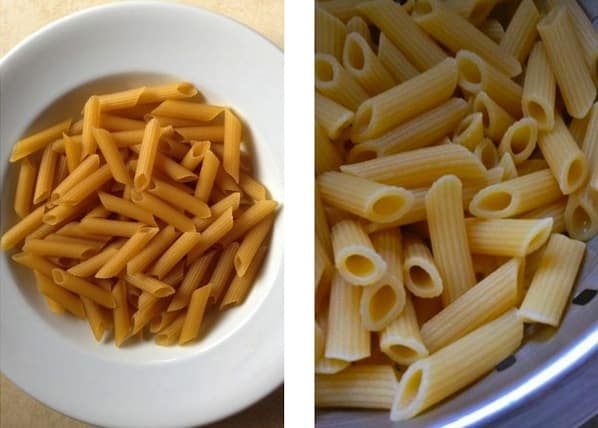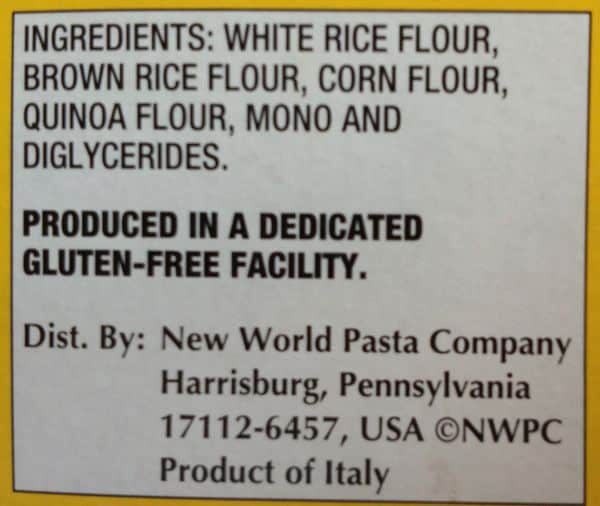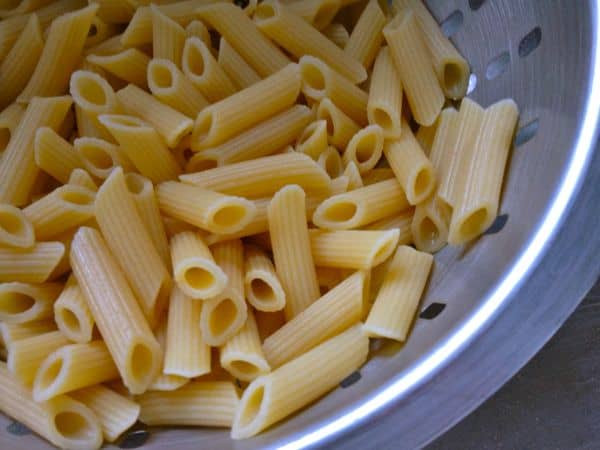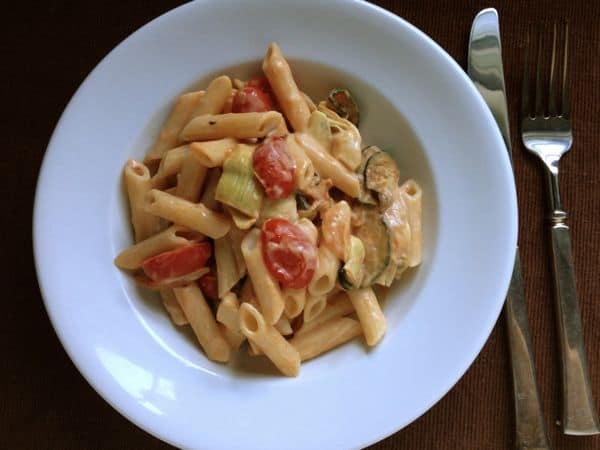
I grew up eating a lot of pasta. How much pasta? Well, both my parents were Italian. Does that give you any idea? We ate so much pasta that in my memory of childhood meals, there’s always a pasta pot on the stove.
So when I learned that Ronzoni, a very mainstream pasta brand across the United States, introduced a line of gluten-free pasta, I wanted to try it! Could this gluten-free Ronzoni pasta taste as good as the pasta I grew up eating?
I grabbed a box of penne at my local supermarket. It surprised me to find the pasta in the “regular” pasta aisle and not shelved in the gluten-free section. The weight of the box disappointed me a little. Instead of a pound like other non-gluten-free Ronzoni pastas, the box gluten-free penne rigate weighed 12 ounces.
What’s up with that? Why can’t gluten-free products include the same amount of product as their gluten-free counterpart? Flour doesn’t come in five pound bags, the Pillsbury cookies I reviewed yesterday are 14 ounces instead of one pound. It would delight me if gluten-free products weighed the same.
Anyway, I digress. In addition to the small size, I noticed that the gluten-free Ronzoni cost considerably more than Ronzoni’s wheat pasta. Bummer. I’d hoped that such a large company could introduce a more budget-friendly gluten-free pasta to the market.
In spite of this, I still couldn’t wait to try the pasta. What can I say? I love the stuff.

I followed my usual method for cooking pasta: a large pot of rapidly boiling water that’s heavily salted. While the Ronzoni box states that salt is optional, I don’t agree. But that’s just me. I like my pasta to contain, you know, flavor.
Made from a blend of rice flours, corn, and quinoa, this blend is a bit different for me. Most of the time, I cook rice-based pasta. I use Tinkyada the most, followed by Trader Joe’s and Jovial. Occasionally I use corn pasta but, honestly, I don’t love it because the corn tends to taste too strong to me. I like my pasta to nicely fade into the background, instead of competing with the sauce or other ingredients.
When rice or corn pastas hit the water, the boiling water turns cloudy. The Ronzoni pasta didn’t do this, at least not as much. The water clouded a bit but it wasn’t nearly as murky was the pasta water I’ve grown accustomed to seeing over the years.
The box claims that the cooking time takes between eight to ten minutes. My pasta took about ten minutes to cook. At that point it wasn’t too tender and it certainly wasn’t mushy. It felt perfectly al dente which is how I like my pasta.
As always, I reserved some of the pasta cooking water and then drained the cooked pasta. It looked….pretty. All of the noodles retained their shape. Sometimes rice pasta, even when al dente, loses its shape. It flattens out just a little. This pasta didn’t do that!
Taste and Texture
While my pasta cooked, I sautéed zucchini slices, onions, and grape tomato halves. In a small pot, I heated up some Alfredo sauce (confession: most of the time I make Alfredo sauce from scratch. But sometimes I don’t. On those days, I use Classico Roasted Garlic Alfredo. It’s pretty good. Just don’t tell my mother. She believes jarred sauce is an abomination. It’ll be our secret, okay?)
It looked good. Even with the sauce and vegetables, the pasta retained its shape. I took a bite. YUM. Like serious YUM. It was as close to love at first bite that I get.
The box of gluten-free Ronzoni pasta claims a “Delicious White Pasta Taste.” At first I wondered why they’d say “white pasta” instead of wheat pasta. Then it dawned on me: most people equate wheat with whole wheat. As you might remember, whole wheat pasta tastes different than “white” pasta. The box was right. This tasted very similar to traditional white pasta.
The bite of this pasta really stood out to me. The texture wasn’t overly firm, nor was it gummy. It really tasted like what you expect from basic dry pasta.

After marveling over the texture, I noticed the taste. Or should I say, I didn’t notice the taste. The pasta didn’t taste too much like corn or quinoa. Like a rice-based pasta, the flavor is mild but not too mild. The pasta added a mild grainy nuttiness to the dish that complemented the rest of the ingredients but didn’t compete with them.
Ingredients
The best part of the ingredient for me is this statement: Produced in a Dedicated Gluten-Free Facility. I worried that Ronzoni would make their gluten-free pasta in a shared facility. Nope! Oh, and the pasta comes from Italy which is interesting. As of this writing, the box didn’t contain any “top eight” allergen statements.
This picture was taken on July 30, 2013. Be sure to read your package in case ingredients or nutrition information change.
Price
At $2.99 for twelve ounces, this pasta costs more than the Tinkyada I currently use. (For me, Tinkyada runs about $2.99 for a pound, a dollar cheaper than the Ronzoni.) I wish it cost less and I wonder if Ronzoni coupons will apply to this product. Call me cynical but I’m guessing that the sales and coupons will only apply to their 16 ounces boxes. (let’s hope I’m wrong!)
Is the price worth it? I think so. The pasta’s pretty great.
Overall
This gluten-free Ronzoni pasta is really lovely. The texture’s great; it tastes great. And since it’s made by a national brand, I’m hopeful that the pasta will be easy to find. That would be so nice! Often when I travel, I notice that gluten-free pasta isn’t always easy to access.
Again, I just wish the box was larger and that it cost a little less. I can’t wait to try the other Ronzoni gluten-free pasta. When I do, I’ll report back!






Roberta Hartford says
I tried this for the first time. I thought it was excellent. I would have never known the difference. I’m definitely a fan!